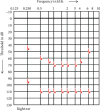Ipsilateral Vestibular Schwannoma after Cochlear Implantation
- PMID: 35223118
- PMCID: PMC8881172
- DOI: 10.1155/2022/4918785
Ipsilateral Vestibular Schwannoma after Cochlear Implantation
Abstract
Objective: The vestibular schwannoma incidence rate is approximately 4.2 per 100,000/year. Thus far, about 700,000 cochlear implantations have been performed worldwide; therefore, the occurrence of vestibular schwannoma postcochlear implantations can be assumed to be infrequent. Recent developments allow safe observation and surveillance of the implanted-side internal auditory canal (IAC) and cochlea by magnetic resonance imaging (MRI), even after cochlear implantation. Patients. A 71-year-old woman with sudden hearing loss and a contralateral vestibular schwannoma without clinical and genetic signs of neurofibromatosis type II. Intervention(s). Ipsilateral cochlear implantation and contralateral vestibular schwannoma extirpation with regular tumor follow-up. Main Outcome Measure(s). Comparison of ipsilateral pre and postcochlear implantation 3T MRI T1 GAD.
Results: We observed a tumor growing at the fundus of the internal auditory canal 1 year after cochlear implantation on the ipsilateral side. Although first detected after cochlear implantation beside a known vestibular schwannoma on the contralateral side, a scan slice thickness of 2 mm cannot fully exclude the preoperative persistence of a small tumor. Based on the clinical findings and after genetic exclusion of NFII, the patient was classified as a NFII mosaic type.
Conclusion: Even after cochlear implantation, tumors in the IAC causing vertigo, facial palsy, and affecting the audiologic outcome can be detected by MRI. The MRI slice thickness used before cochlear implantation should be under 2 mm.
Copyright © 2022 S. Tüpker et al.
Conflict of interest statement
The authors declare that they have no conflicts of interest.
Figures






References
Publication types
LinkOut - more resources
Full Text Sources
Research Materials

